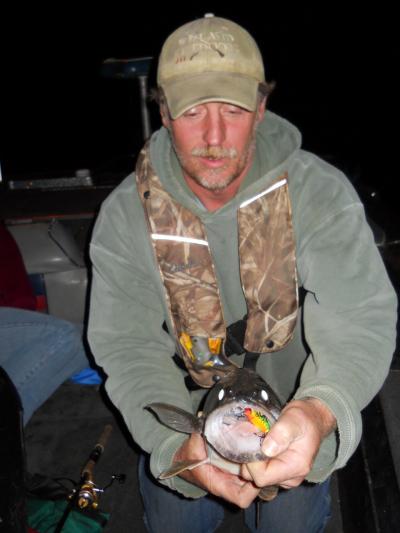I’ve been spending the last couple days sorting gear and identifying what I’m missing or low on. As I’m finding a few broken bills, cracked bodies, hooks I missed for replacing…I just couldn’t help day dreaming about the next night that I get to dump the boat in and enjoy crank’n some eyes.
I know there is plenty of ice yet to be drilled and explored. But there is definitely something that creates an adrenaline rush for me that can’t be matched when it comes to walleyes crushing crank baits in 39 degree water. Maybe it’s more being intrigued that all day walleyes will thump or tick plastics. Don’t get me wrong, Moxies, Pulse-Rs, ringworms, and other quality plastics are snatched up by some mighty big eyes. But it’s that flip of a switch at night when walleyes rise out of 12 to 20 feet of water and go absolutely nuts, just smashing cranks at times just inches below the surface.
I’m also looking forward to exploring more water and finding the mini-ecosytems that are out there that most guys just drive by. I’m still fascinated by how different the presentation can be on each different river system I fish can be, yet so similar.
Last year I had a lot of PMs asking for more assistance in locating the type of structure I look to crank on. For me it’s not only the general location, its what that location has to offer in relationship to the habits of the fish. I’m not an expert by any means on the Mississippi River – though it is where my heart is at.
First, I like to know what specific attribute the fish want. Is it remnants of cattails, wood, clam beds, pea gravel, rock, or weeds. Next, its finding that attribute in areas of pockets, current breaks, isolated spots on a vast blank shoreline. Then I look at the the access to deep water. If I know the fish during the day are hanging in 16 to 20 feet, I look for near by areas that the fish will most likely move into – possibly as shallow as 2fow.
My most aggressive feeding locations I hit tend to be a shelf as apposed to a gradual drop off. Possible a pocket along the main channel that offers a current break that is 1/2 to a 1/3 of the main channel current.
On the Wolf river system, many fo these spots are the mouths to a slough or marsh. On the Miss, they seem to be more isolated around a subtle variation in the shoreline creating an eddy or seam.
Transition spots like the beginning or end of rip/rap shores also provide ideal early feeding areas. Especially if there is timber or other attributes to the habitat for holding baitfish or other food offerings.
Next is selecting which cranks I throw. Surprisingly, I think that has become the easiest task to figure out. I look at two things immediately. Profile and depth. The consistency I have found on different waters is the preference of body shape. When I used to wade the WI River. from Prairie Du Sac, long stick baits by far out produced shad raps. The Wolf River system has proved for me to be smaller sticks. The Mississippi most frequently for me has been body or taller profile baits. Now its just matching the depth range I want to cover. If I’m on a shelf that rises from 16 fow to 3 fow, I’ll generally start with something that will run 5′. After fanning across the shallow pocket, I’ll go to the 7′-10′ and work the drop off edge. Very seldom am I ever tossing anything that will track deeper than 12′.
If I’m tossing along cattails or timber, I generally opt for a lipless or a bill design that will get me the tick/pause -release. A favorite thing to have has been suspending baits. Once I know the feel of the bottom, I’ll run a suspending Rainbow Smelt down until it is almost in the snag, then “work it” around and through without ripping it the snag.
For color – I think that discussion could go on until the end of time. The last couple years I have become a huge fan of the more natural colors. “Match the hatch” type of thinking. Without a doubt, Pearls, Chartreuse, Purple, Orange, and so on have all had their place and time. In some places, they do get eaten more and I’m always open to roll with their program. They are biting it – not me.
Anyways, I had some time to kill as I nurse a hangover and figured I’ll do something constructive 
So what do you look for to have success with early eyes on cranks?





 .. Gonna give it a try
.. Gonna give it a try 